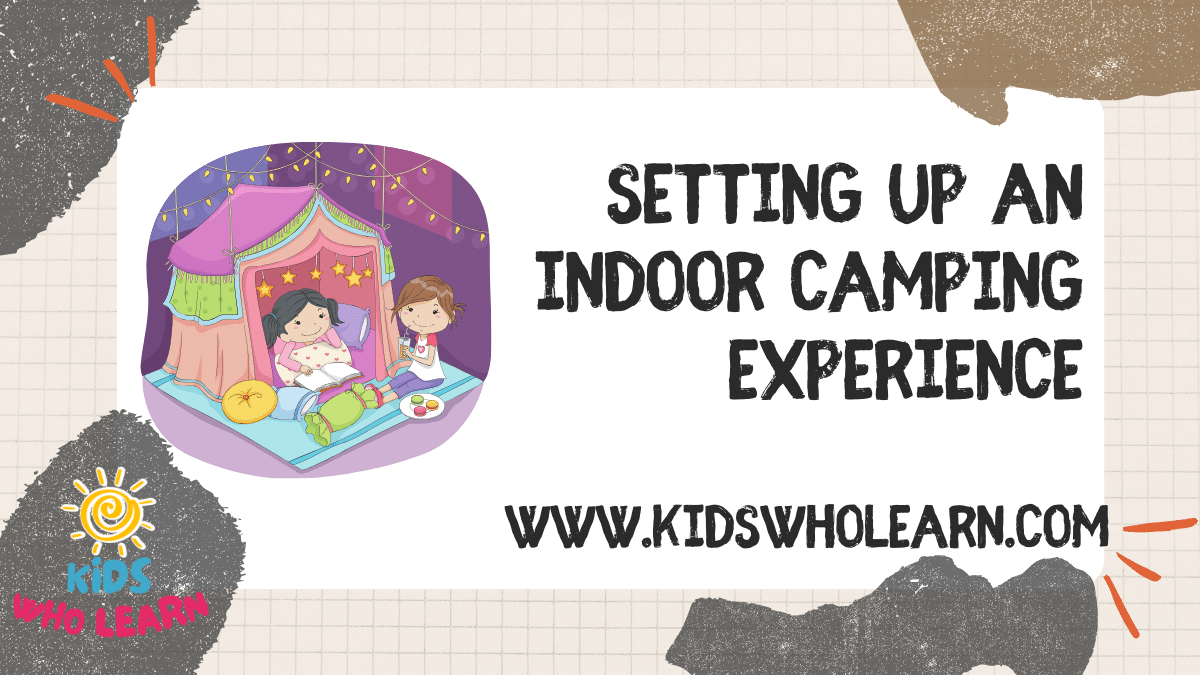Stepping away from the bustle of outdoor camping, crafting an indoor camping experience offers the charm of camping combined with the comforts of home. Whether the weather outside is frightful or you’re seeking a unique adventure for the family, transforming your living space into a camping zone can provide endless entertainment and an unconventional way to create lasting memories.
Planning an indoor camping trip requires a touch of creativity and foresight. You’ll want to select a spot in your home that can be dedicated to setting up a tent or a makeshift fort – the living room or a spacious area is often an ideal choice. Equipping the space with sleeping bags, pillows, and comfortable bedding will ensure a cozy night’s sleep. To add to the ambiance, stringing fairy lights or lanterns can offer a gentle, starry glow reminiscent of a night under the open sky.
Integrating natural elements and planning engaging activities are central to enriching the indoor camping experience. Indoor-safe camping cuisine, from roasting marshmallows by an artificial campfire to preparing picnic-style meals, can bring the taste of the outdoors inside. Themed games, storytelling, and even indoor stargazing with projected constellations can keep campers entertained. For those adapting this experience during a pandemic or other restrictions, it proves an inventive way to break the monotony safely, fostering a sense of adventure from the comfort of your living space.
Key Takeaways
- Indoor camping blends the excitement of traditional camping with home comforts.
- Careful planning ensures a memorable and comfortable indoor camping experience.
- Creative activities and indoor-appropriate camping meals enhance the atmosphere.
Planning Your Indoor Camping Experience
Creating an unforgettable indoor camping experience begins with careful planning. You’ll need to choose a suitable space, gather essential equipment, consider safety, create a welcoming ambiance, develop a themed environment, and prepare for comfort regardless of indoor weather conditions.
Choosing the Right Space
Select a spacious area within your home, living room or bedroom, to set up your indoor campsite. Opt for an area large enough to accommodate a real tent or a makeshift fort, leaving room for movement and additional activities.
Gathering Essential Equipment
Assemble your camping essentials:
- Tent: Whether using a real tent or constructing a fort, make sure it can fit within your chosen area.
- Sleeping Arrangements: Include sleeping bags, pillows, blankets, and cushions for comfort.
- Lighting: Equip your space with lights such as flashlights, a headlamp, or camp lights.
Safety Considerations and Setup
Safety is paramount. Avoid real flames; opt for candles, a faux fire pit, or use a fireplace if available. Ensure there’s sufficient airflow and that the tent doesn’t block exits.
Campsite Decoration and Ambiance
Enhance the space with nature-inspired decorations:
- Plants and rocks to simulate outdoor scenery.
- String lights for a starry night effect on the ceiling.
- Nature sounds or forest sounds for aural immersion.
Creating a Themed Environment
Develop a theme for the camping experience. Hang posters of the night sky or forest views on walls or near a large window. Utilize toys or stuffed animals to mimic wildlife.
Weather Preparation and Comfort
Address indoor climate considerations to ensure comfort:
- If feeling chilly, have extra blankets and warm clothing on hand.
- Use fans for air circulation in a warmer setting.
- Adjust room temperature to a comfortable level prior to setup.
Camping Activities and Entertainment
Creating an indoor camping experience offers a unique opportunity for engaging fun and entertainment. Tailor activities to the time of day for an authentic camping rhythm, incorporating family time focused on young children, exercise, and relaxation.
Daytime Indoor Camping Activities
For daytime fun, consider setting up a scavenger hunt where you hide camping-themed items or pictures of animals and birds around the house. Compile a list of items for your family to find and offer a small prize for the winner.
- Scavenger Hunt: Hide items for a nature-themed search.
- Make Believe: Create your own campsite with tents, a fake fire pit, and stuffed animal ‘wildlife’.
- Camping Exercise: Simulate a nature hike indoors or follow a workout video with an outdoor theme.
- Toys and Crafts: Offer a variety of toys and crafting supplies to make animals or nature scenes.
Children, especially young kids, will delight in these hands-on activities that can help them learn about nature while also providing meaningful exercise and playtime.
Evening Entertainment and Campfire Alternatives
When evening falls, it’s time to gather around your pretend campfire. A string of orange lights or a crafted paper fire can set the ambiance. This imaginative campfire is the perfect spot to enjoy classic camping entertainment.
- Movie Night: Choose a film with an outdoor adventure theme.
- Ghost Stories: Share spooky tales or read from a book of campsite-friendly ghost stories.
- Shadow Puppets: Use a lamp to create animal shadow figures on the wall.
In this cozy atmosphere, singing campfire songs becomes a highlight, allowing family members to express themselves musically and build memories together.
Unplugged Fun: Games and Storytelling
Indulge in unplugged fun by dusting off the board games or dealing out a deck of cards for an evening of gaming. Games such as charades or Pictionary encourage creativity and family bonding.
- Board Games: Classic or camping-themed games.
- Card Games: From Go Fish to Rummy, suitable for all ages.
- Storytelling: Share stories, whether personal or fictitious, to ignite the imagination.
These activities not only provide entertainment but also prompt conversation, developing communication skills in younger campers.
Outdoor Adventure Simulation
To give a sense of real outdoor adventure:
- Nature Sounds: Play recordings of crickets chirping or water flowing to bring the outdoors in.
- Camping Games: Set up indoor-friendly versions of horseshoes or bean bag toss.
- Animal Identification: Use flashcards to teach children about different animals and birds.
These activities offer a taste of the great outdoors while maintaining the comfort of being indoors, perfect for days when weather or circumstances keep you inside.
Camping Cuisine: Indoor Cooking and Food
Transform your indoor camping adventure with delicious and convenient food options that evoke the true spirit of camping without leaving your home. Explore simple cooking methods, enjoyable meal preparations, and the joy of campfire-style treats made right in your kitchen.
Convenient Cooking Options
When selecting your cooking method, a portable camping stove or indoor grill is essential for authenticity. These appliances allow you to make traditional camping meals safely inside:
- Grilled burgers: A timeless camping favorite.
- Stove-top sautéed vegetables: For a quick and nutritious side dish.
Cooking Tips:
- Always use appliances according to their instructions to ensure safety.
- Pre-cook certain ingredients to save time during your indoor camping.
Preparing and Enjoying Camping Meals
Focus on easy camping meal suggestions that require minimal preparation. This can include:
- Foil-pack dinners: Combine meat, veggies, and seasonings, then cook on your grill or stove.
- One-pot pasta: A simple, yet filling meal option.
Remember, the key to enjoyable camping meals is simplicity and ease of preparation.
Meal Ideas:
- Pasta with a sauce of your choice, complemented by grilled chicken or sausage.
- Pre-made salads for a refreshing and easy side.
Indoor S’mores and Camping Snacks
No camping experience is complete without s’mores and snacks:
- Indoor s’mores: Use your stove to roast marshmallows and sandwich them with chocolate between graham crackers.
- Camping snacks: Prepare trail mix, popcorn, or have bowls of nuts and dried fruits available for grazing.
For s’mores, you can also experiment with different chocolates or toppings to add variety. Snack-wise, think about a balance of sweet and savory, and have snacks readily accessible to enjoy throughout your indoor camping adventure.
Sleep Arrangements and Overnight Comfort
Creating a cozy sleep space is crucial for an enjoyable indoor camping experience. You’ll want to focus on ensuring comfort throughout the night, just as if you were outdoors.
Choosing a Sleeping Surface: An air mattress can provide a soft and elevated sleeping surface replicating a real bed. For a closer-to-nature feel, spread out sleeping bags on the floor. Make sure to pick a flat area free of furniture that could disrupt your sleep.
Structure Your Bedding:
- Lay down a thick blanket or a sleeping pad underneath your sleeping bag for added cushioning.
- Use a sleeping bag suitable for indoor temperatures or choose blankets that can be easily adjusted with changes in your room’s climate.
- Include a comfortable pillow to support your neck.
Ensuring Warmth: Nights can get chilly, even indoors. Have extra blankets on hand to layer up if needed. Synthetic or wool blankets provide good insulation, while cotton ones are great for a lighter cover.
Tips for Enhanced Comfort:
- If using an air mattress, inflate it to a firmness level that supports your back.
- Flannel-lined sleeping bags add an extra touch of warmth and softness.
- Quality pillows can make a significant difference—consider bringing your favorite from your bedroom.
By focusing on these details, your indoor camping sleep arrangements will contribute to a delightful and restful overnight experience.
Integrating Nature into Your Indoor Camping
Creating an immersive indoor camping experience hinges on incorporating elements of the great outdoors into your indoor setup. Think of your living space as a canvas for recreating the serenity of nature.
Using Plants and Natural Elements
First, introduce various plants to your indoor campsite to emulate the feeling of being surrounded by greenery. Small trees like the indoor Norfolk Island Pine or tabletop succulents mimic a forest’s variety. Arrange ferns and broad-leafed plants to create a lush environment. You can even create a centerpiece with a collection of rocks or a bowl of pine cones to solidify the natural setting.
- Plants to Consider:
- Norfolk Island Pine
- Succulents
- Ferns
- Natural Decor:
- Rocks
- Pine cones
- Twigs
Enhancing the Experience with Sounds and Visuals
To deepen the sense of being outdoors, integrate auditory and visual elements. Play a mix of nature sounds such as crickets chirping at dusk, birds calling in the morning, or the soothing ambience of water flowing. For visuals, project a starry night sky onto the ceiling for stargazing, or use forest-themed wall projections to create a panoramic view.
Sounds to Play:
- Nighttime: Crickets, owls
- Daytime: Bird songs, rustling leaves
- Water: Streams, light rain
Visuals to Project:
- Starry night sky for stargazing
- Panoramic forest scenes
Concluding the Indoor Camping Experience
Wrapping up your indoor camping experience efficiently allows you to preserve the positive memories while maintaining an orderly home. Follow these guidelines to ensure everything is taken care of properly.
Cleanup and Storage Guidelines
Cleanup:
- Dismantle tents and sleeping bags. Shake out any debris before folding.
- Wipe down equipment such as lanterns or cooking gear with a damp cloth.
- Sweep the area to ensure no crumbs or small waste is left behind.
Storage:
- Store tents and sleeping bags in dry, cool places to prevent mold.
- Place smaller items like flashlights or cookware in labeled containers for easy retrieval.
Reflecting on the Experience
- Take a moment to share any comments or thoughts with your fellow campers; it strengthens the bond and the overall experience.
- Discuss what you enjoyed the most and any areas for improvement.
Planning for Future Indoor Camping Adventures
- List what worked well and what you might want to change for the next indoor camping trip.
- Begin planning future adventures; consider different themes or activities to keep the experience fresh and exciting.
By following these suggestions, your transition from the excitement of your indoor camping back to your regular routine will be smooth and stress-free, setting the stage for many more memorable home-based adventures.
Adapting to Circumstances: Indoor Camping During a Pandemic
With the onset of the coronavirus pandemic, adapting your leisure activities to safe, indoor environments became crucial. Indoor camping is a novel way to recreate the adventure of the outdoors within the confines of your home. By transforming your living room floor into a campsite, you can keep the spirit of camping alive while adhering to health guidelines.
Preparation:
- Space Selection: Choose a spacious area like your living room floor for ample room to set up your tent and camping gear.
- Ventilation: Ensure good air circulation by opening windows—this is essential to mimic a fresh outdoor atmosphere and maintain a healthy indoor environment.
Setting Up:
- Tent Placement: Position your tent in the center of the chosen space, securing it safely without causing damage to your home interiors.
- Sleeping Arrangements: Equipping the tent with sleeping bags and comfortable pillows will enhance your indoor camping experience.
Activities:
- Campfire Simulation: No camping is complete without a campfire. Use LED candles or a virtual fireplace video to create a safe and cozy campfire.
- Stargazing Alternative: Hang glow-in-the-dark stars from the ceiling to simulate a starry night.
Safety:
- Cleanliness: Frequently sanitize your hands and camping equipment.
- Health Precautions: If camping with others from outside your household, maintain appropriate distancing and wear masks when necessary.
When adapting to indoor camping, maintaining a balance between fun and safety is key. With a little creativity, you can enjoy an authentic camping experience without stepping outside your home.
Frequently Asked Questions
In this section, you’ll find practical advice and creative ideas to enhance your indoor camping experience, from set-up to activities.
What are creative ways to set up an indoor camping tent to enhance the experience?
To create an engaging indoor camping tent, consider using string lights for a starry effect, bringing in plush pillows for comfort, and constructing a fort with blankets and furniture to mimic a true campsite atmosphere.
Can you suggest a variety of food options suitable for an indoor camping experience?
Offering a mix of classic campfire treats like s’mores made in the microwave and healthy snacks such as trail mix and fruit kebabs can appeal to all tastes. Include some indoor grilling with a portable electric grill for a barbecue vibe.
What are some engaging indoor camping craft activities suitable for all ages?
Crafting faux campfires from construction paper and tissue paper or making friendship bracelets can be enjoyable for any age. Setting up a DIY lantern project could also add to the fun.
How can one arrange an intimate indoor camping date night?
To arrange a romantic indoor camping date night, add soft lighting with candles or fairy lights, play nature sounds in the background, and create a cozy nest with an air mattress and sleeping bags. Share stories or watch a camping-themed movie to complete the night.
Which activities are recommended for preschoolers during an indoor camping adventure?
For preschoolers, a scavenger hunt with pictures or simple riddles can be exciting. Incorporating animal walks or simulating a fishing game with magnetic fish and poles can also keep them entertained and engaged.
What are fun and age-appropriate ideas for hosting an indoor camping birthday party?
An indoor camping birthday party can feature a tent or tepee for storytelling, a “campfire” sing-along with a pretend fire, and blanket forts for imaginative play. Include camping-themed games and crafts tailored to the ages of the attendees.













